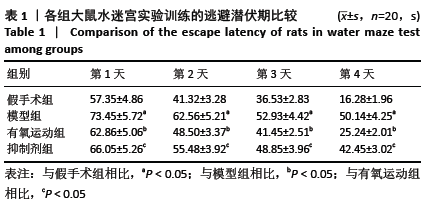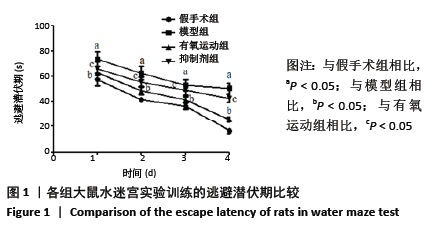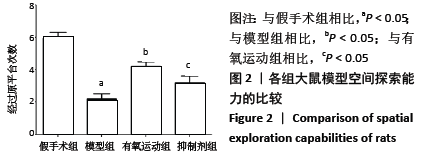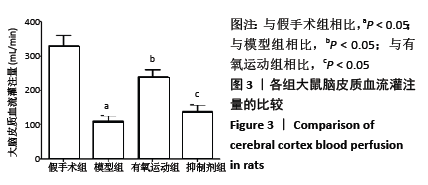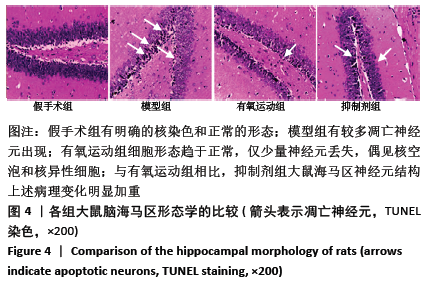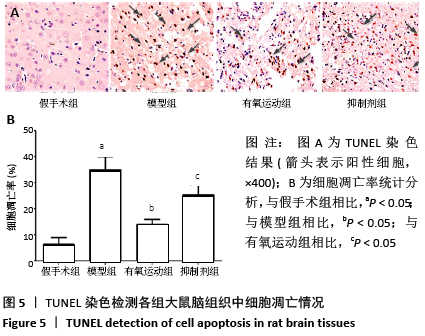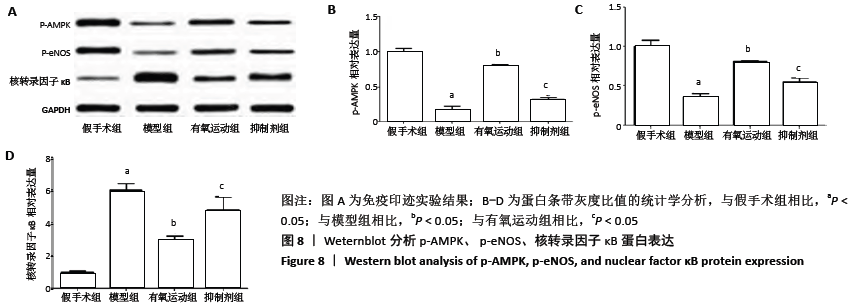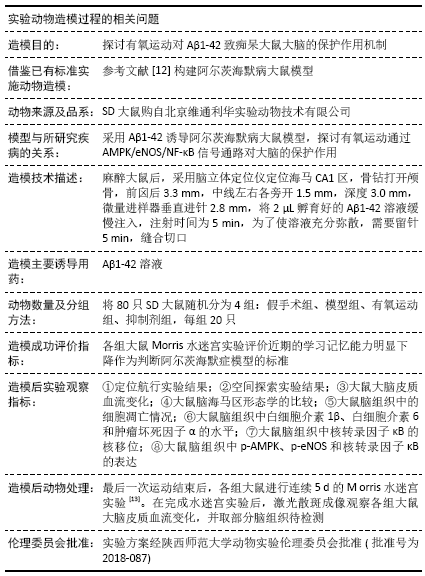[1] 余云舟, 徐青. 靶向β-淀粉样蛋白的阿尔茨海默病免疫治疗研究进展[J]. 国际药学研究杂志,2016,43(2):216-223.
[2] FU X, KE M, YU W, et al. Periodic Variation of AAK1 in an Aβ 1–42 -Induced Mouse Model of Alzheimer’s Disease. J Mol Neurosci. 2018; 65(2):179-189.
[3] AREA-GOMEZ E, SCHON EA. Mitochondria-associated ER membranes and Alzheimer disease. Curr Opin Genet Dev. 2016;38:90-96.
[4] 王茹, 王少朋, 杜菊梅, 等.有氧运动改善老年脑小血管病大鼠淡漠行为机制的研究[J]. 实用老年医学,2019,33(3):219.
[5] XIE X, YANG C, CUI Q, et al. Stachydrine mediates rapid vascular relaxation: activation of endothelial nitric oxide synthase involving AMPK and Akt phosphorylation in vascular endothelial cell. J Agric Food Chem. 2019;67(35):9805-9811.
[6] WANG Z, ZHOU W, DONG H, et al. Dexmedetomidine pretreatment inhibits cerebral ischemia/reperfusion induced neuroinflammation via activation of AMPK. Mol Med Rep. 2018;18(4):3957-3964.
[7] YUAN Y, ZHANG Z, WANG ZG, et al. MiRNA-27b regulates angiogenesis by targeting AMPK in mouse ischemic stroke model. Neuroscience. 2019;398(1):12-22.
[8] 牟连伟, 李岩, 顾博雅,等. 有氧运动改善AD模型中枢神经元线粒体通透性转换孔功能[J]. 北京体育大学学报,2019(1):138-146.
[9] 李擎,杨坚,范利,等.监控下持续靶强度有氧运动对脑卒中合并冠心病患者有氧代谢能力和体质指标的影响[J].中国康复医学杂志,2016,31(2):183-188.
[10] PAXINOS. The rat brain in stereotaxic coordinates( Compact Third Edition). San Diego. California, USA: Academic Press. 2005:8.
[11] 周永战, 陈佩杰, 肖卫华. 规律性有氧运动对常见慢性疾病的抗炎效应及其机制[J]. 中国康复医学杂志,2019,34(8):974-979.
[12] 李汉文, 武衡. 金帕龙对阿尔茨海默病大鼠记忆功能的改善作用及分子机制研究[J]. 中华神经医学杂志,2019,18(4):331-336.
[13] 池晓红, 刘朝敏, 姜鹤群,等. ECS对去势小鼠学习记忆障碍作用在Morris水迷宫和神经电生理长时程增强方面的研究[J]. 临床和实验医学杂志,2019,18(10):5-8.
[14] 刘峻, 田锦勇, 涂丽,等. 吡格列酮联合盐酸多奈哌齐对阿尔兹海默症患者血清中免疫炎症因子,Aβ1-42蛋白和Tau蛋白的影响[J].免疫学杂志,2019,35(1):48-53.
[15] LI NM, LIU KF, QIU YJ, et al. Mutations of beta-amyloid precursor protein alter the consequence of Alzheimer’s disease pathogenesis. Neural Regen Res. 2019;14(4):658-665.
[16] CECHELLA JL, LEITE MR, PINTON S, et al. Neuroprotective Benefits of Aerobic Exercise and Organoselenium Dietary Supplementation in Hippocampus of Old Rats. Mol Neurobiol. 2018;55(5):3832-3840.
[17] NIU Y, WAN C, ZHOU B, et al. Aerobic exercise relieved vascular cognitive impairment via NF-κB/miR-503/BDNF pathway. Am J Transl Res. 2018;10(3):753-761.
[18] LI L, XU M, SHEN B, et al. Moderate exercise prevents neurodegeneration in D-galactose-induced aging mice. Neural Regen Res. 2016;11(5): 807-815.
[19] 唐量,亢依婷,尹博,等.负重爬梯与有氧跑台运动对糖尿病大鼠学习记忆能力的影响及其机制探讨[J].中国应用生理学杂志, 2017,33(5):436-440.
[20] MAURUS I, HASAN A, RÖH A,et al. Neurobiological effects of aerobic exercise, with a focus on patients with schizophrenia. Eur Arch Psychiatry Clin Neurosci. 2019;269(5):499-515.
[21] 田锋, 胡力旬.有氧运动联合高压氧对全脑缺血再灌注大鼠认知功能、血脑屏障及氧自由基的影响[J].中华航海医学与高气压医学杂志, 2018, 25(2):81-85.
[22] 谈畅, 刘瑷瑜, 苏榆婷, 等.阿尔茨海默病基于灰质体积和脑血流量的研究进展[J]. 中华行为医学与脑科学杂志, 2019,28(1):91-94.
[23] TROFIMOV AO, KALENTYEV G, VOENNOV O, et al. The Cerebrovascular Resistance in Combined Traumatic Brain Injury with Intracranial Hematomas. Acta Neurochir Suppl. 2018;126:25-28.
[24] YAN H, YAN Z, NIU X, et al. Dl-3-n-butylphthalide can improve the cognitive function of patients with acute ischemic stroke: a prospective intervention study. Neurol Res. 2017;39(4):337-343.
[25] 闫妍, 韩冉, 高俊峰,等. 地黄引子改善AD大鼠脑组织线粒体生物合成与氧化损伤的机制[J].中国实验方剂学杂志, 2018,24(21): 105-110.
[26] DAS BC, DASGUPTA S, RAY SK. Potential therapeutic roles of retinoids for prevention of neuroinflammation and neurodegeneration in Alzheimer’s disease. Neural Regen Res. 2019;14(11):1880-1892.
[27] BAI XL, YANG XY, LI JY, et al. Cavin-1 regulates caveolae-mediated LDL transcytosis: crosstalk in an AMPK/eNOS/ NF-κB/Sp1 loop. Oncotarget. 2017;8(61):103985-103995.
[28] JIAN M, KWAN JS, BUNTING M, et al. Adiponectin suppresses amyloid-β oligomer (AβO)-induced inflammatory response of microglia via AdipoR1-AMPK-NF-kB signaling pathway. J Neuroinflammation. 2019; 16(1):110.
[29] 吴杰, 杜彩萍. 基于AMPK/eNOS/NF-κB信号通路探讨虾青素对脑梗死大鼠的影响及作用机制[J]. 中国动脉硬化杂志,2018,26(12): 38-43.
[30] QIU F, ZHANG H, YUAN Y, et al. A decrease of ATP production steered by PEDF in cardiomyocytes with oxygen-glucose deprivation is associated with an AMPK-dependent degradation pathway.Int J Cardiol. 2018;257:262-271.
[31] 周慧,刘敬,侯文锋,等.小檗碱活化AMPK-eNOS减轻油酸所致人主动脉内皮细胞损伤[J].食品科学,2018,39(5):213-219.
[32] JIANG Y, DU H, LIU X, et al. Artemisinin alleviates atherosclerotic lesion by reducing macrophage inflammation via regulation of AMPK/NF-κB/NLRP3 inflammasomes pathway. J Drug Target. 2020;28(1):70-79.
[33] ZHANG L, QIN Q, LIU M, et al. Akkermansia muciniphila can reduce the damage of gluco/lipotoxicity, oxidative stress, and inflammation and normalize intestine microbiota in streptozotocin-induced diabetic rats.Pathog Dis. 2018;31(3):1125-1129 .
[34] 王石艳.有氧运动对AD及MCI患者认知和运动功能干预作用的研究[D]. 南京:南京医科大学, 2015.
[35] 李小龙.有氧运动改善阿尔茨海默病大鼠认知功能损害的中枢免疫机制的研究[D]. 太原:太原理工大学,2016.
|

